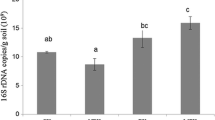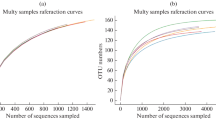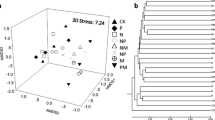Abstract
Fertilization is an important factor influencing the chemical structure of soil organic carbon (SOC) and soil microbial communities; however, whether any connection exists between the two under different fertilization regimes remains unclear. Soils from a 27-year field experiment were used to explore potential associations between SOC functional groups and specific bacterial taxa, using quantitative multiple cross-polarization magic-angle spinning 13C nuclear magnetic resonance and 16S rRNA gene sequencing. Treatments included balanced fertilization with organic materials (OM) and with nitrogen (N), phosphorus (P), and potassium (K) mineral fertilizers (NPK); unbalanced fertilization without one of the major elements (NP, PK, or NK); and an unamended control. These treatments were divided into four distinct groups, namely OM, NPK, NP plus PK, and NK plus control, according to their bacterial community composition and SOC chemical structure. Soil total P, available P, and SOC contents were the major determinants of bacterial community composition after long-term fertilization. Compared to NPK, the OM treatment generated a higher aromatic C–O and OCH3 and lower alkyl C and OCH abundance, which were associated with the enhanced abundance of members of the Acidobacteria subgroups 6 and 5, Cytophagaceae, Chitinophagaceae, and Bacillus sp.; NP plus PK treatments resulted in a higher OCH and lower aromatic C–C abundance, which showed a close association with the enrichment of unclassified Chloracidobacteria, Syntrophobacteraceae, and Anaerolineae and depletion of Bacillales; and NK plus control treatments resulted in a higher abundance of aromatic C–C, which was associated with the enhanced abundance of Bacillales. Our results indicate that different fertilization regimes changed the SOC chemical structure and bacterial community composition in different patterns. The results also suggest that fertilization-induced variations in SOC chemical structure were strongly associated with shifts in specific microbial taxa which, in turn, may be affected by changes in soil properties.




Similar content being viewed by others
References
Accoe F, Boeckx P, Van Cleemput O, Hofman G, Hui X, Bin H, Chen GX (2002) Characterization of soil organic matter fractions from grassland and cultivated soils via C content and δ13C signature. Rapid Commun Mass Spectrom 16:2157–2164
Amend AS, Seifert KA, Bruns TD (2010) Quantifying microbial communities with 454 pyrosequencing: does read abundance count? Mol Ecol 19:5555–5565
Asano M, Wagai R (2015) Distinctive organic matter pools among particle-size fractions detected by solid-state 13C-NMR, δ13C and δ15N analyses only after strong dispersion in an allophanic Andisol. Soil Sci Plant Nutr 61:242–248
Baldock JA, Oades JM, Waters AG, Peng X, Vassallo AM, Wilson MA (1992) Aspects of the chemical structure of soil organic materials as revealed by solid-state 13C NMR spectroscopy. Biogeochemistry 16:1–42
Balesdent J, Mariotti A, Guillet B (1987) Natural 13C abundance as a tracer for studies of soil organic matter dynamics. Soil Biol Biochem 19:25–30
Banerjee S, Kirkby CA, Schmutter D, Bissett A, Kirkegaard JA, Richardson AE (2016) Network analysis reveals functional redundancy and keystone taxa amongst bacterial and fungal communities during organic matter decomposition in an arable soil. Soil Biol Biochem 97:188–198
Barros Soares EM, Silva IR, de Novais RF, Hu Y-Y, Schmidt-Rohr K (2013) Alterations in molecular composition of humic substances from eucalypt plantation soils assessed by 13C-NMR spectroscopy. Soil Sci Soc Am J 77:293–306
Blagodatskaya E, Kuzyakov Y (2008) Mechanisms of real and apparent priming effects and their dependence on soil microbial biomass and community structure: critical review. Biol Fertil Soils 45:115–131
Bot A, Benites J (2005) The importance of soil organic matter: key to drought-resistant soil and sustained food and production. Food and Agriculture Organization of the United Nations, Rome, pp 1–75
Bryant DA, Costas AMG, Maresca JA, Chew AGM, Klatt CG, Bateson MM, Tallon LJ, Hostetler J, Nelson WC, Heidelberg JF, Ward DM (2007) Candidatus Chloracidobacterium thermophilum: an aerobic phototrophic acidobacterium. Science 317:523–526
Cao XY, Lattao C, Pignatello JJ, Mao JD, Schmidt-Rohr K (2014) Sorption selectivity in natural organic matter probed with fully deuterium-exchanged and carbonyl-13C-labeled benzophenone and 1H-13C NMR spectroscopy. Environ Sci Technol 48:8645–8652
Caporaso JG, Kuczynski J, Stombaugh J, Bittinger K, Bushman FD, Costello EK, Fierer N, Pena AG, Goodrich JK, Gordon JI, Huttley GA, Kelley ST, Knights D, Koenig JE, Ley RE, Lozupone CA, McDonald D, Muegge BD, Pirrung M, Reeder J, Sevinsky JR, Tumbaugh PJ, Walters WA, Widmann J, Yatsunenko T, Zaneveld J, Knight R (2010) QIIME allows analysis of high-throughput community sequencing data. Nat Methods 7:335–336
Clarke KR (1993) Nonparametric multivariate analyses of changes in community structure. Aust J Ecol 18:117–143
Core Team R (2012) R: a language and environment for statistical computing. R Foundation for statistical computing, Vienna
Cruz AF, Hamel C, Hanson K, Selles F, Zentner RP (2009) Thirty-seven years of soil nitrogen and phosphorus fertility management shapes the structure and function of the soil microbial community in a Brown Chernozem. Plant Soil 315:173–184
Cucurachi M, Busconi M, Marudelli M, Soffritti G, Fogher C (2013) Direct amplification of new cellulase genes from woodland soil purified DNA. Mol Biol Rep 40:4317–4325
Das SN, Sarma PVSRN, Neeraja C, Malati N, Podile AR (2010) Members of Gammaproteobacteria and Bacilli represent the culturable diversity of chitinolytic bacteria in chitin-enriched soils. World J Microbiol Biotechnol 26:1875–1881
De la Cruz-Barron M, Cruz-Mendoza A, Navarro-Noya YE, Ruiz-Valdiviezo VM, Ortiz-Gutierrez D, Ramirez-Villanueva DA, Luna-Guido M, Thierfelder C, Wall PC, Verhulst N, Govaerts B, Dendooven L (2017) The bacterial community structure and dynamics of carbon and nitrogen when maize (Zea mays L.) and its neutral detergent fibre were added to soil from Zimbabwe with contrasting management practices. Microb Ecol 73:135–152
De’ath G (2006) mvpart: multivariate partitioning. R package version 1.2–6. Available at: http://cran.r-project.org/
Demoling F, Figueroa D, Bååth E (2007) Comparison of factors limiting bacterial growth in different soils. Soil Biol Biochem 39:2485–2495
Ding JL, Jiang X, Ma MC, Zhou BK, Guan DW, Zhao BS, Zhou J, Cao FM, Li L, Li J (2016) Effect of 35 years inorganic fertilizer and manure amendment on structure of bacterial and archaeal communities in black soil of Northeast China. Appl Soil Ecol 105:187–195
Dixon P (2003) VEGAN, a package of R functions for community ecology. J Veg Sci 14:927–930
Eo J, Park KC (2016) Long-term effects of imbalanced fertilization on the composition and diversity of soil bacterial community. Agric Ecosyst Environ 231:176–182
Eshetu B, Jandl G, Leinweber P (2012) Compost changed soil organic matter molecular composition: a Py-GC/MS and Py-FIMS study. Compost Sci Util 20:230–238
Estendorfer J, Stempfhuber B, Haury P, Vestergaard G, Rillig MC, Joshi J, Schroeder P, Schloter M (2017) The influence of land use intensity on the plant-associated microbiome of Dactylis glomerata L. Front Plant Sci 8:930
Fang XW, Chua T, Schmidt-Rohr K, Thompson ML (2010) Quantitative 13C NMR of whole and fractionated Iowa Mollisols for assessment of organic matter composition. Geochim Cosmochim Acta 74:584–598
Fierer N, Bradford MA, Jackson RB (2007) Toward an ecological classification of soil bacteria. Ecology 88:1354–1364
Fontaine S, Mariotti A, Abbadie L (2003) The priming effect of organic matter: a question of microbial competition? Soil Biol Biochem 35:837–843
Francioli D, Schulz E, Lentendu G, Wubet T, Buscot F, Reitz T (2016) Mineral vs. organic amendments: microbial community structure, activity and abundance of agriculturally relevant microbes are driven by long-term fertilization strategies. Front Microbiol 7:1446
Frostegård Å, Tunlid A, Bååth E (1993) Phospholipid fatty acid composition, biomass, and activity of microbial communities from two soil types experimentally exposed to different heavy metals. Appl Environ Microbiol 59:3605–3617
Goldfarb KC, Karaoz U, Hanson CA, Santee CA, Bradford MA, Treseder KK, Wallenstein MD, Brodie EL (2011) Differential growth responses of soil bacterial taxa to carbon substrates of varying chemical recalcitrance. Front Microbiol 2:94
Gressel N, McColl JG, Preston CM, Newman RH, Powers RF (1996) Linkages between phosphorus transformations and carbon decomposition in a forest soil. Biogeochemistry 33:97–123
Jackson ML (1958) Soil chemical analysis. Englewood Cliffs, New Jersey
Jiménez-González MA, Álvarez AM, Hernández Z, Almendros G (2018) Soil carbon storage predicted from the diversity of pyrolytic alkanes. Biol Fertil Soils 54:617–629
Jing ZW, Chen RR, Wei SP, Feng YZ, Zhang JB, Lin XG (2017) Response and feedback of C mineralization to P availability driven by soil microorganisms. Soil Biol Biochem 105:111–120
Kiem R, Knicker H, Korschens M, Kögel-Knabner I (2000) Refractory organic carbon in C-depleted arable soils, as studied by 13C NMR spectroscopy and carbohydrate analysis. Org Geochem 31:655–668
Kivlin SN, Winston GC, Goulden ML, Treseder KK (2014) Environmental filtering affects soil fungal community composition more than dispersal limitation at regional scales. Fungal Ecol 12:14–25
Kögel-Knabner I (2002) The macromolecular organic composition of plant and microbial residues as inputs to soil organic matter. Soil Biol Biochem 34:139–162
Li ZQ, Zhao BZ, Wang QY, Cao XY, Zhang JB (2015) Differences in chemical composition of soil organic carbon resulting from long-term fertilization strategies. PLoS One 10:e0124359
Li F, Chen L, Zhang JB, Yin J, Huang SM (2017) Bacterial community structure after long-term organic and inorganic fertilization reveals important associations between soil nutrients and specific taxa involved in nutrient transformations. Front Microbiol 8:187
Lian TX, Wang GH, Yu ZH, Li YS, Liu XB, Zhang SQ, Herbert SJ, Jin J (2017) Bacterial communities incorporating plant-derived carbon in the soybean rhizosphere in Mollisols that differ in soil organic carbon content. Appl Soil Ecol 119:375–383
Liu J, Sui Y, Yu Z, Shi Y, Chu H, Jin J, Liu X, Wang G (2014) High throughput sequencing analysis of biogeographical distribution of bacterial communities in the black soils of Northeast China. Soil Biol Biochem 70:113–122
Liu LL, Kong JJ, Cui HL, Zhang JB, Wang FH, Cai ZC, Huang XQ (2016) Relationships of decomposability and C/N ratio in different types of organic matter with suppression of Fusarium oxysporum and microbial communities during reductive soil disinfestation. Biol Control 101:103–113
Louca S, Jacques SMS, Pires APF, Leal JS, Gonzalez AL, Doebeli M, Farjalla VF (2017) Functional structure of the bromeliad tank microbiome is strongly shaped by local geochemical conditions. Environ Microbiol 19:3132–3151
Mao JD, Schmidt-Rohr K (2004) Accurate quantification of aromaticity and nonprotonated aromatic carbon fraction in natural organic matter by 13C solid-state nuclear magnetic resonance. Environ Sci Technol 38:2680–2684
Miltner A, Bombach P, Schmidt-Brücken B, Kästner M (2012) SOM genesis: microbial biomass as a significant source. Biogeochemistry 111:41–55
Nannipieri P, Ascher J, Ceccherini MT, Landi L, Pietramellara G, Renella G (2003) Microbial diversity and soil functions. Eur J Soil Sci 54:655–670
Ng EL, Patti AF, Rose MT, Schefe CR, Wilkinson K, Smernik RJ, Cavagnaro TR (2014) Does the chemical nature of soil carbon drive the structure and functioning of soil microbial communities? Soil Biol Biochem 70:54–61
Olsen SR, Cole CV, Watanabe FS, Dean LA (1954) Estimation of available phosphorus in soils by extraction with sodium bicarbonate. Washington DC
Page AL, Miller RH, Keeney DR (1982) Methods of soil analysis, part 2, chemical and microbiological properties. Madison, WI
Pascault N, Ranjard L, Kaisermann A, Bachar D, Christen R, Terrat S, Mathieu O, Leveque J, Mougel C, Henault C, Lemanceau P, Pean M, Boiry S, Fontaine S, Maron PA (2013) Stimulation of different functional groups of bacteria by various plant residues as a driver of soil priming effect. Ecosystems 16:810–822
Pathma J, Sakthivel N (2013) Molecular and functional characterization of bacteria isolated from straw and goat manure based vermicompost. Appl Soil Ecol 70:33–47
Pedersen JA, Simpson MA, Bockheim JG, Kumar K (2011) Characterization of soil organic carbon in drained thaw-lake basins of Arctic Alaska using NMR and FTIR photoacoustic spectroscopy. Org Geochem 42:947–954
Randall EW, Mahieu N, Powlson DS, Christensen BT (1995) Fertilization effects on organic matter in physically fractionated soils as studied by 13C NMR: results from two long-term field experiments. Eur J Soil Sci 46:557–565
Reshef DN, Reshef YA, Finucane HK, Grossman SR, McVean G, Turnbaugh PJ, Lander ES, Mitzenmacher M, Sabeti PC (2011) Detecting novel associations in large data sets. Science 334:1518–1524
Shannon P, Markiel A, Ozier O, Baliga NS, Wang JT, Ramage D, Amin N, Schwikowski B, Ideker T (2003) Cytoscape: a software environment for integrated models of biomolecular interaction networks. Genome Res 13:2498–2504
Simonetti G, Francioso O, Nardi S, Berti A, Brugnoli E, Lugato E, Morari F (2012) Characterization of humic carbon in soil aggregates in a long-term experiment with manure and mineral fertilization. Soil Sci Soc Am J 76:880–890
Skjemstad JO, Frost RL, Barron PF (1983) Structural units in humic acids from southeastern Queensland soils as determined by 13C NMR spectroscopy. Aust J Soil Res 21:539–547
Skjemstad JO, Clarke P, Taylor JA, Oades JM, Newman RH (1994) The removal of magnetic materials from surface soil. A soild state 13C CP/MAS NMR study. Aust J Soil Res 32:1215–1229
Solomon D, Lehmann J, Thies J, Schaefer T, Liang B, Kinyangi J, Neves E, Petersen J, Luizao F, Skjemstad J (2007) Molecular signature and sources of biochemical recalcitrance of organic C in Amazonian Dark Earths. Geochim Cosmochim Acta 71:2285–2298
Su JQ, Ding LJ, Xue K, Yao HY, Quensen J, Bai SJ, Wei WX, Wu JS, Zhou JZ, Tiedje JM, Zhu YG (2015) Long-term balanced fertilization increases the soil microbial functional diversity in a phosphorus-limited paddy soil. Mol Ecol 24:136–150
Tan H, Barret M, Mooij MJ, Rice O, Morrissey JP, Dobson A, Griffiths B, O’Gara F (2013) Long-term phosphorus fertilisation increased the diversity of the total bacterial community and the phoD phosphorus mineraliser group in pasture soils. Biol Fertil Soils 49:661–672
Tapia-Torres Y, Rodriguez-Torres MD, Elser JJ, Islas A, Souza V, Garcia-Oliva F, Olmedo-Alvarez G (2016) How to live with phosphorus scarcity in soil and sediment: lessons from bacteria. Appl Environ Microbiol 82:4652–4662
Tian J, Lou Y, Gao Y, Fang H, Liu S, Xu M, Blagodatskaya E, Kuzyakov Y (2017) Response of soil organic matter fractions and composition of microbial community to long-term organic and mineral fertilization. Biol Fertil Soils 53:523–532
Turner BL, Lambers H, Condron LM, Cramer MD, Leake JR, Richardson AE, Smith SE (2013) Soil microbial biomass and the fate of phosphorus during long-term ecosystem development. Plant Soil 367:225–234
Wang H, Liu SR, Wang JX, Shi ZM, Xu J, Hong PZ, Ming AG, Yu HL, Chen L, Lu LH, Cai DX (2016) Differential effects of conifer and broadleaf litter inputs on soil organic carbon chemical composition through altered soil microbial community composition. Sci Rep 6:27097
Wang HY, Nie Y, Butterly CR, Wang L, Chen QH, Tian W, Song BB, Xi YG, Wang Y (2017) Fertilization alters microbial community composition and functional patterns by changing the chemical nature of soil organic carbon: a field study in a Halosol. Geoderma 292:17–24
Xia M, Zhao BZ, Xiying H, Zhang JB (2015) Soil quality in relation to agricultural production in the North China Plain. Pedosphere 25:592–604
Xia Y, Wang YB, Wang Y, Chin FYL, Zhang T (2016) Cellular adhesiveness and cellulolytic capacity in Anaerolineae revealed by omics-based genome interpretation. Biotechnol Biofuels 9:111
Xun WB, Xu ZH, Li W, Ren Y, Huang T, Ran W, Wang BR, Shen QR, Zhang RF (2016) Long-term organic-inorganic fertilization ensures great soil productivity and bacterial diversity after natural-to-agricultural ecosystem conversion. J Microbiol 54:611–617
Yan X, Zhou H, Zhu QH, Wang XF, Zhang YZ, Yu XC, Peng X (2013) Carbon sequestration efficiency in paddy soil and upland soil under long-term fertilization in southern China. Soil Tillage Res 130:42–51
Yang Y, Li X, Liu J, Zhou Z, Zhang T, Wang X (2017) Bacterial diversity as affected by application of manure in red soils of subtropical China. Biol Fertil Soils 53:639–649
Yu HY, Ding WX, Chen ZM, Zhang HJ, Luo JF, Bolan N (2015) Accumulation of organic C components in soil and aggregates. Sci Rep 5:13804
Zech W, Senesi N, Guggenberger G, Kaiser K, Lehmann J, Miano TM, Miltner A, Schroth G (1997) Factors controlling humification and mineralization of soil organic matter in the tropics. Geoderma 79:117–161
Zhang A, Zhao G, Gao T, Wang W, Li J, Zhang S, Zhu B (2013a) Solubilization of insoluble potassium and phosphate by PaenibacilluskribensisCX-7: a soil microorganism with biological control potential. Afr J Microbiol Res 7:41–47
Zhang HJ, Ding WX, Yu HY, He XH (2013b) Carbon uptake by a microbial community during 30-day treatment with C-13-glucose of a sandy loam soil fertilized for 20 years with NPK or compost as determined by a GC-C-IRMS analysis of phospholipid fatty acids. Soil Biol Biochem 57:228–236
Zhang JC, Zhang L, Wang P, Huang QW, Yu GH, Li DC, Shen QR, Ran W (2013c) The role of non-crystalline Fe in the increase of SOC after long-term organic manure application to the red soil of southern China. Eur J Soil Sci 64:797–804
Zhang YL, Yao SH, Mao JD, Olk DC, Cao XY, Zhang B (2015) Chemical composition of organic matter in a deep soil changed with a positive priming effect due to glucose addition as investigated by 13C NMR spectroscopy. Soil Biol Biochem 85:137–144
Zhao BZ, Chen J, Zhang JB, Qin SW (2010) Soil microbial biomass and activity response to repeated drying-rewetting cycles along a soil fertility gradient modified by long-term fertilization management practices. Geoderma 160:218–224
Zhao BZ, Chen J, Zhang JB, Xin XL, Hao XY (2013) How different long-term fertilization strategies influence crop yield and soil properties in a maize field in the North China Plain. J Plant Nutr Soil Sci 176:99–109
Zhou ZG, Chen N, Cao XY, Chua T, Mao JD, Mandel RD, Bettis EA III, Thompson ML (2014) Composition of clay-fraction organic matter in Holocene paleosols revealed by advanced solid-state NMR spectroscopy. Geoderma 223:54–61
Acknowledgements
We thank editor-in-chief Prof. Nannipieri and two anonymous reviewers for their constructive comments and suggestions that improved the manuscript greatly.
Funding
Funding for the work was provided by the National Key R&D Program of China (2016YFD0300802, 2016YFD0200107), the earmarked fund for China Agriculture Research System (CARS-03), and the Science and Technology Service Network Initiative (KFJ-SW-STS-142-03).
Author information
Authors and Affiliations
Corresponding author
Rights and permissions
About this article
Cite this article
Li, D., Chen, L., Xu, J. et al. Chemical nature of soil organic carbon under different long-term fertilization regimes is coupled with changes in the bacterial community composition in a Calcaric Fluvisol. Biol Fertil Soils 54, 999–1012 (2018). https://doi.org/10.1007/s00374-018-1319-0
Received:
Revised:
Accepted:
Published:
Issue Date:
DOI: https://doi.org/10.1007/s00374-018-1319-0




